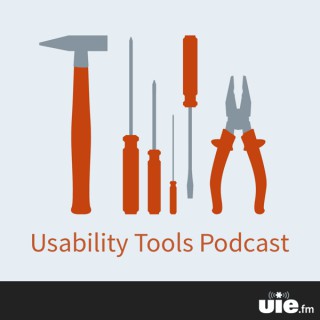Usability Tools Podcast
Follow Usability Tools PodcastJared Spool discusses tips and tools for improving your site's user experience with Christine Perfetti and Brian Christiansen. They share someone UIE's most important findings from our decades of research on web design and usability.
Jared Spool & Brian Christiansen
- Jul 22, 2008 LATEST EPISODE
- infrequent NEW EPISODES
- 23m AVG DURATION
- 18 EPISODES
Latest episodes from Usability Tools Podcast

In this episode of Usability Tools, Brian Christiansen and I continue on how to moderate a usability test.

In this episode of Usability Tools, Brian Christiansen and I talk about how to moderate a usability test. Turns out, the episode got so long that we decided to break it into two parts. This week's show focuses upon the different roles a single moderator needs to take on during the session.

A button is a button right? Move the mouse over it. Click. Not much to it, eh? Well, when it’s a well-designed button, all the work your brain is doing to click the button is invisible to you. However, when it’s poorly designed, things start to become harder. Maybe you overshoot the target area? Or maybe you have trouble clicking because the button is too small. Often its not difficult to recover, but it costs attention and attention is expensive. In this week’s podcast, we discuss the implications of Fitts’ Law. In short, the law states, “The time to acquire a target is a function of the distance to and size of the target.”

In this week’s podcast, Brian Christiansen and I continue exploring usability techniques for web-based applications. This week, we explore the usability technique toolbox, focusing on those methods that help us with web-based applications.

In this week's podcast, Brian Christiansen and I explore usability techniques for web-based applications. Web-based applications are different from content-based web sites because the users are involved in a transaction. When we're researching the usability of a content-based site, we're focused on how users will find and react to the information. However, with web-based applications, there are many other considerations that we need to account for. Because this is a big topic, we've divided it into two podcasts. In Part 1, Brian and I lay down the framework for what our usability research needs to tell us about our web-based application. In Part 2, will look at the techniques for finding that information.

It's tempting to spend a ton of time creating slick flyout, dropdown, or pop-up navigation on our site, but is it worth the effort? This week, Brian Christiansen and I discuss interactive mouseover techniques for navigation. Are they a good idea when it comes to actually using your site? Based on our testing, we don’t think so.

This week, we discuss avoiding redesigns. When we talk about avoiding redesigns, we don’t think your should stay anchored in the past, far from it. But we think the best route to change is through incremental deployment.

In this week's episode, Brian Christiansen and I discuss the experience of on-site search engines, how to tell if yours is working well, and how to improve it.

This week, we follow up our Virtual Seminar presentation on Building Robust Personas In 30 Days or Less, with answers to more questions that were generated during the session. You needn't have attended the seminar to learn from this podcast, though.

Statistical significance revolves around having enough participants to make your findings valid. However, the number of participants necessary can vary widely, depending on what you’re studying and how. Join us for a podcast that will help you understand how to make this determination for your projects.

In the design world, there’s always been an assumption that some users demonstrate “search-dominant” tendencies by going right to the search engine when they first visit a web site looking for content. But back in 2000, UIE made a groundbreaking claim that blew away the web design world. From our research, we concluded that users aren’t Search dominant. How does this effect your design choices?

In usability tests where we incorporate interview-based tasks, the participants interests are discovered, not assigned. Unlike traditional task design methods, the test facilitator and participant negotiate the tasks during the tests, instead of proceeding down a list of predefined tasks. There are many situations where this is the appropriate way to test a product.

This week, Christine Perfetti asks Jared Spool about User Interface Engineering’s groundbreaking study on download time. In this study, we found the actual download time of a page didn’t impact a site’s usability.

This week, Christine Perfetti asks Jared Spool about one of UIE's most valuable usability testing techniques, Inherent Value Tests. Inherent Value Testing gives the team important information about how well a web site communicates the inherent value the designers are putting into the site.

This week, Christine and Jared discuss the genesis and value of five-second usability tests.

In last week's podcast, we talked about Gallery Pages, which are pages with links to the site’s content pages. This week, Christine asked me about two other types of pages: Department pages and Store pages. These pages become crucial when an information-rich site has thousands (and sometimes millions) of pages.

In this week’s episode, Christine Perfetti asks Jared Spool about UIE’s research on Gallery Pages. Gallery Pages, the list of links to content, are a web site’s hardest working page. They are the final page that determine whether users will successfully find their content.

In this Usability Tools podcast, Christine Perfetti asks Jared Spool about UIE's latest thinking on home page design.








